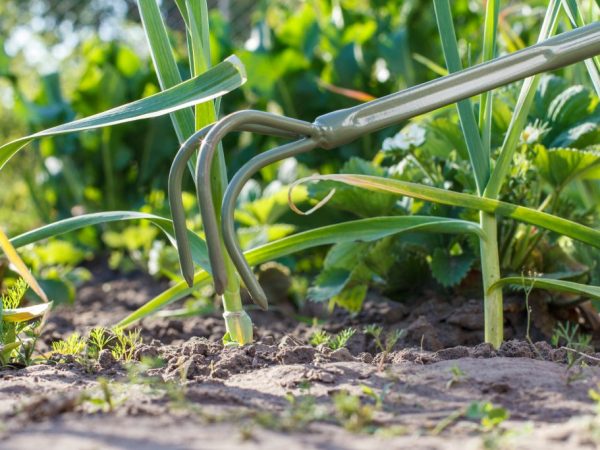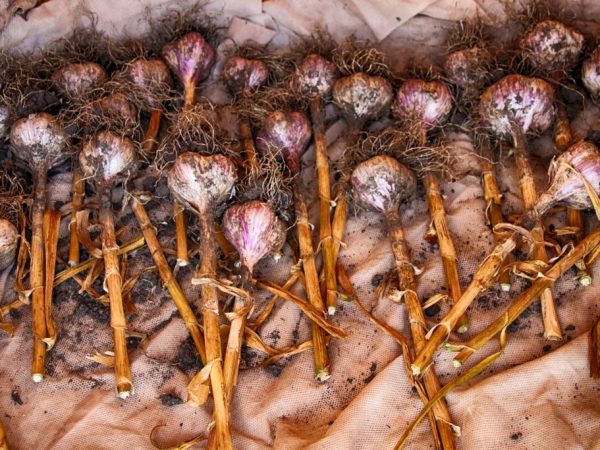The timing of digging garlic in the Moscow region
The duration and quality of storage depends on the time of harvesting the garlic. It is often difficult to determine the optimal harvest time, but knowing when to dig up garlic in the Moscow region is important to get a rich harvest.

The timing of digging garlic in the Moscow region
When to clean
The timing of digging up the garlic depends on the following factors:
- weather conditions;
- landing time;
- method of planting.
The period of biological ripeness of fruits in different areas of the country is approximately the same. The differences relate only to weather conditions and the time of establishment of summer temperature. This contributes to the active growth of the bulbs, the determination of the harvest time of the crop.
Weather conditions determine a lot. In a temperate climate, the heads ripen quickly, as a result, the harvest is carried out at the end of July. If during the cultivation period there was a lot of rain, sharp temperature fluctuations, the bulbs are dug out ahead of time, and then dried in dry rooms.
The type of culture also plays a role. Winter garlic is planted in garden beds in the fall, before the snow falls, it manages to take root and start growing. In the spring, growth processes take place early in it, the heads fully ripen at the beginning of summer. This variety forms large bulbs and produces large yields. You can distinguish it from the spring one by its high erect stems.
Spring, or summer, garlic is planted in spring. It has a shortened growing season and is harvested at the end of July. This variety has a lower yield, its heads are smaller than that of winter crops, but it is better and longer stored.
All factors affecting the timing of harvesting the garlic bulbs should be considered. This allows you to dig them up on time and without waste.
When to dig up winter garlic
Ripening of winter garlic occurs in mid-July. In regions with a temperate climate, bulbs are dug out of the beds around 25 July. In the Moscow region, the growing season increases, the harvesting time comes a week later.
After full ripening, the heads of garlic are left to lie in the garden for 5-7 days. During this time, the bulbs will finally ripen and dry out. Such material is stored without loss.
When to harvest spring garlic
Spring garlic grows a little longer than winter garlic. It is removed 15 days later.
Typically, harvesting time is mid to late August. In northern regions with colder climates, they try to dig up the heads before September 5. Harvesting dates change slightly every year. The reason for this is the rains, which can shift the harvest time even to mid-September.
Signs of Ripening Garlic

Do not water the garlic before digging.
Whether the garlic is ripe or not is determined by its appearance: the lower leaves turn yellow and fall. This should be in July. If the same is observed in spring or early summer, the reason is a violation of the irrigation regime or exposure to pests.
The maturity of the culture is also determined by the arrows that form on the plant in mid-June. They are broken out so that all the nutrients go to the formation of bulbs.Only 2-3 signal arrows are left on the garden bed, which indicate whether the garlic is ripe or not.
Ready-to-harvest garlic has a firm and straight arrow. The pod at the top of the arrow should be cracked and the seeds should be looking out.
The method for determining maturity by arrows is acceptable only for winter garlic, since spring garlic does not form them. In this embodiment, they monitor the leaves and stems. In a ripe vegetable, they dry out completely and lie on the ground.
The ripeness of the bulb is checked by digging one of the soil. For a fully ripe, the following symptoms are characteristic:
- the head is dense and hard to the touch;
- the fruit is covered with 3 or more layers of scales;
- the teeth are easily separated;
- The cover film is easily removed from the teeth.
It is imperative to collect the bulbs in a timely manner, otherwise the heads will crack, exposing the teeth. Such fruits cannot be stored for a long time and used for planting next year.
Harvesting and storage
Watering of plants is stopped 30 days before harvesting. A week before harvesting, the garlic is slightly dripped in, which speeds up the ripening stage of the bulbs. A warm sunny day is selected for cleaning.
The cleaning sequence consists of the following steps:
- The fruits are dug in with a pitchfork or shovels. Bulbs are not pulled out of the ground: this harms the teeth.
- Use your hands to free the bulbs from soil residues. It is forbidden to shake or beat the garlic on the ground: it is severely injured, as a result, it cannot be stored for a long time.
- For final drying, the dug out bulbs are laid out in liquid rows for 3-4 days.
- On the fourth day, dry leaves and stalks of garlic are cut off, the fruits are sorted by size and stored.
If, after harvesting, the crop is immediately placed in a special room for drying, it can be protected from sudden rains. In this case, the garlic will dry to the desired condition for at least 2 weeks.
Small vegetables are best consumed immediately. Medium and large fruits are well stored, so they are left for the winter.
Different storage methods are chosen. Most often, garlic is packed in cardboard boxes and kept in a dry place. Sometimes the bulbs are laid with layers of parchment.
Garlic is also stored in wicker baskets. Better aeration is created in them, the crop is preserved with practically no waste. Among gardeners there are also those who weave bundles from bulbs and keep the crop hanging.
Winter varieties are stored in a cellar or refrigerator. Spring garlic is preserved better than winter garlic; even in a warm room, it does not lose its quality.
Conclusion
It is important not only to grow quality bulbs, but also to dig them up in a timely manner. The ripening time for garlic in the Moscow region varies, depending on the variety and weather. When to dig, it is determined by the appearance of the culture. Proper storage of the crop is equally important.

